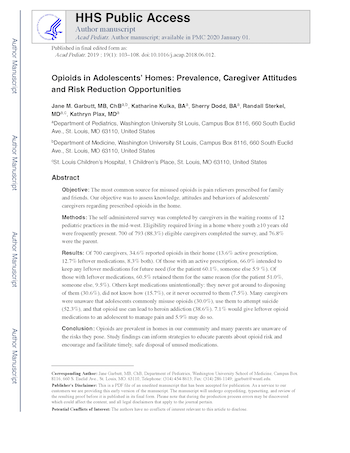Opioid Misuse
2017

Opioids in Adolescents’ Homes: Prevalence, Caregiver Attitudes, and Risk Reduction Opportunities
January 1, 2019
Garbutt JM, Kulka K, Dodd S, Sterkel R, Plax K. Opioids in Adolescents’ Homes: Prevalence, Caregiver Attitudes, and Risk Reduction Opportunities. Acad Pediatr. 2019 Jan-Feb;19(1):103-108. doi: 10.1016/j.acap.2018.06.012. Epub 2018 Jul 6. PMID: 29981856; PMCID: PMC6914255.
Objective
To assess knowledge, attitudes and behaviors of adolescents’ caregivers regarding prescribed opioids in the home.
Design
A self-administered survey was completed by caregivers in the waiting rooms of 12 pediatric practices in the St. Louis metropolitan area. Eligibility required living in a home where youth ≥10 years old were frequently present.
Results
Of 700 caregivers, 34.6% reported opioids in their home (13.6% active prescription, 12.7% leftover medications, 8.3% both). Of those with an active prescription, 66.0% intended to keep any leftover medications for future need (for the patient 60.1%, someone else 5.9 %). Of those with leftover medications, 60.5% retained them for the same reason (for the patient 51.0%, someone else, 9.5%). Others kept medications unintentionally: they never got around to disposing of them (30.6%), did not know how (15.7%), or it never occurred to them (7.5%). Many caregivers were unaware that adolescents commonly misuse opioids (30.0%), use them to attempt suicide (52.3%), and that opioid use can lead to heroin addiction (38.6%). 7.1% would give leftover opioid medications to an adolescent to manage pain and 5.9% may do so.
Conclusion
Opioids are prevalent in homes in our community and many parents are unaware of the risks they pose. Study findings can inform strategies to educate parents about opioid risk and encourage and facilitate timely, safe disposal of unused medications.